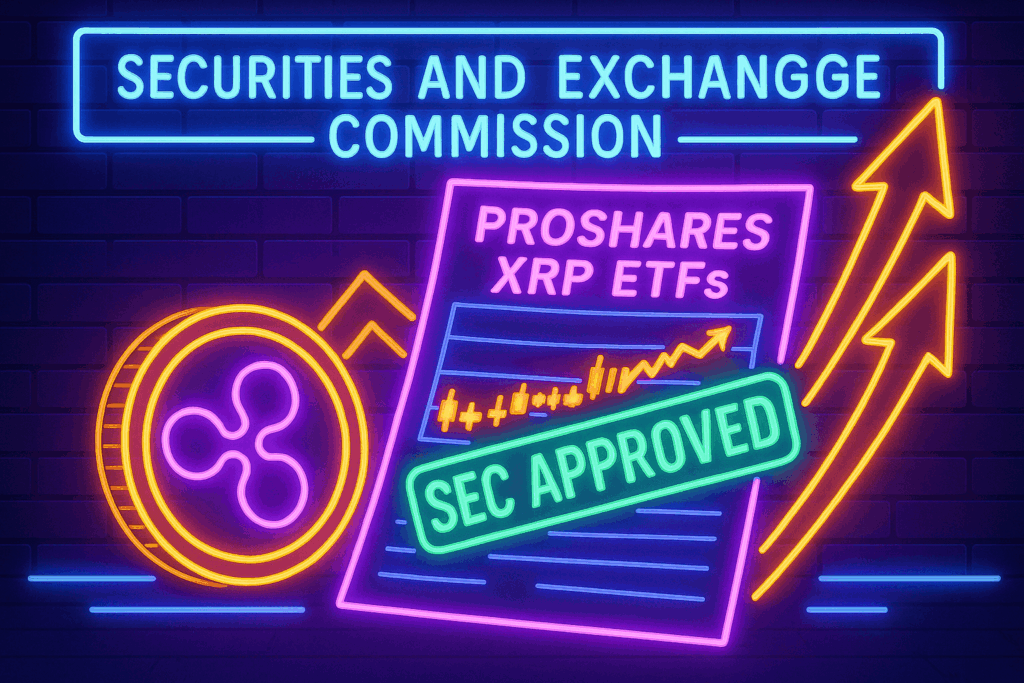
SEC Approval of ProShares XRP Futures ETFs: What Investors Need to Know
April 28, 2025
In a landmark decision, the U.S. Securities and Exchange Commission (SEC) has green-lit three XRP futures exchange-traded funds (ETFs) from ProShares. Set to list on April 30, the Ultra XRP ETF (2× long), the Short XRP ETF (–1× inverse) and the Ultra Short XRP ETF (–2× inverse) grant regulated, margin-free access to both bullish and bearish XRP exposure. This article dissects the approval, product mechanics, market impact, and tactical plays — then shows how Paypilot’s unified crypto ecosystem lets you capitalize on the new instruments.
Regulatory Context: Why Futures Before Spot
The SEC’s cautious posture toward spot crypto ETFs is well documented. By approving futures-based products first, the agency leverages a framework it trusts: cash-settled contracts traded on Commodity Futures Trading Commission (CFTC)-regulated venues. Futures indexes dampen concerns over token custody, market manipulation and surveillance gaps, while allowing capital markets to test investor appetite under the Investment Company Act of 1940.
Ripple’s partial courtroom victory earlier this year, which clarified that “programmatic sales” of XRP are not securities, paved the way for this decision. However, the SEC still seeks iron-clad spot-market surveillance agreements before rubber-stamping a physical XRP ETF. Until then, futures wrappers serve as a regulatory halfway house.
Product Mechanics: How the New ETFs Work
Ultra XRP ETF (2× Long)
Aims to deliver 200 percent of the daily return of the Bloomberg XRP Futures Index. Gains and losses are amplified; compounding effects can diverge from the headline multiple over multi-day holding periods.
Short XRP ETF (–1× Inverse)
Seeks the opposite of the index’s daily move. A one-percent fall in XRP futures should translate into a one-percent rise in the ETF on the same day, excluding fees and tracking error.
Ultra Short XRP ETF (–2× Inverse)
Targets –200 percent of the daily performance, offering a capital-efficient hedge for sophisticated traders. Because downside exposure compounds, disciplined risk management is critical.
All three funds reset daily. Investors planning multi-week or multi-month holds must monitor tracking drift, volatility decay and roll costs when front-month futures expire.
Market Context: XRP’s Evolving Derivatives Stack
The ETFs arrive amid a flurry of infrastructure upgrades:
- CME Group is slated to list cash-settled XRP futures next month, adding institutional depth to an asset already logging billions in daily spot turnover.
- Teucrium’s XXRP, a 2× leveraged ETF launched earlier in April, scored over $5 million in first-day volume, proving latent demand for magnified XRP exposure.
- Global momentum is building: Brazil’s B3 now hosts a spot XRP ETF, while Hong Kong’s HashKey Capital just rolled out an XRP tracker fund aimed at Asian institutions.
Collectively, these milestones point to an XRP derivatives stack that is maturing as quickly as those of Bitcoin and Ether. Liquidity begets liquidity: every new futures market tightens spreads, stabilizes funding rates and draws additional market-making capital.
Price and Liquidity Impact
Historically, futures-based ETFs catalyze two liquidity flywheels:
- Arbitrage Loop: Authorized participants create and redeem ETF shares against futures baskets, compressing premiums and anchoring the ETF to its net asset value.
- Volatility Transfer: Directional traders move from unregulated perpetual swaps to regulated ETFs, softening wild wick moves on offshore exchanges.
XRP’s spot price popped roughly three percent on approval news, a sentiment bid rather than a structural rerating. Sustained price lift depends on whether the funds attract persistent inflows. Early flows in comparable Bitcoin futures ETFs ran \$500 million in week one; even a tenth of that directed at XRP could nudge liquidity metrics and bid-ask spreads meaningfully tighter.
Institutional Angle: Why Professional Desks Care
Portfolio managers have wrestled with three pain points in altcoin exposure: custody, compliance and liquidity. Futures ETFs solve two and partially address the third:
- Custody Risk Eliminated — No on-chain token storage; positions settle in cash.
- Compliance Friendly — 1940 Act governance, audited statements and exchange surveillance agreements tick key due-diligence boxes.
- Liquidity Uptrend — Adding CME futures plus ETF AP arbitrage deepens order books and reduces slippage for block trades.
Some multi-strategy funds plan to rotate a slice of their altcoin sleeve into the Ultra XRP ETF for tactical momentum plays, while hedging via the Short XRP ETF to stay beta-neutral at the portfolio level.
Strategic Playbook for Investors
Bullish Momentum Swings — Deploy the Ultra XRP ETF after confirmed breakout candles; target one-to-three-day time frames to mitigate leverage decay.
Hedging Spot Holdings — Long-only treasuries can cap downside by allocating a proportional notional to the Short XRP ETF. A 0.5 percent position may neutralize a five-percent portfolio drawdown in sharp sell-offs.
Pairs and Dispersion Trades — Hedge systemic crypto risk by longing Ultra XRP and shorting an equivalent notional in leveraged Bitcoin or Ether ETFs when XRP-specific catalysts (legal wins, partnerships) surface.
Cash-and-Carry Basis — Exploit futures premiums by buying spot XRP via our OTC desk, shorting Ultra XRP ETF units and capturing the convergence as contracts settle.
Paypilot Angle: Turning ETF Volatility into Everyday Utility
- Deep-Liquidity OTC — Execute block creations or redemptions of XRP ETF units through our OTC desk, avoiding on-screen slippage.
- Smart-Yield Wallet — Park idle cash legs in a high-yield crypto wallet, auto-swept into regulated money-market tokens at up to 4 percent APR.
- Real-Time Conversion — Realize ETF gains, swap to stablecoins, and spend instantly via the Paypilot crypto card with zero FX fees across Europe.
- Unified Risk Dashboard — Monitor spot XRP, ETF deltas and hedges in one console, complete with volatility alerts and funding-rate analytics.
Key Risks and Mitigations
Tracking Error & Volatility Decay
Leveraged ETFs amplify not just returns but also path dependency. Use them for short tactical windows; rebalance frequently or pair-trade to offset drift risks.
Roll Cost & Contango
When futures trade above spot (contango), rolling positions forward erodes value. Track implied roll yield and consider closing positions ahead of front-month expiry to minimize bleed.
Regulatory Overhang
An abrupt SEC policy shift on leverage limits—or the outcome of pending spot ETF applications—could reshape demand. Maintain position sizing discipline and diversify across crypto exposures.
Road to a Spot XRP ETF
With ProShares’ futures launch secured, market focus pivots to spot ETF filings from Grayscale, Bitwise, Franklin Templeton and 21Shares. Approval odds have risen after Ripple’s courtroom win, yet the SEC still wants tighter on-chain surveillance. Policy insiders suggest 2025-2026 as a realistic window. In the interim, futures ETFs—and OTC desks that bridge fiat, stablecoins and XRP—will dominate institutional flow.
Final Word
The SEC’s clearance of ProShares’ XRP futures ETFs cements XRP’s status as a core component of the institutional crypto toolkit. These products unlock leveraged long, inverse and hedging capabilities within a regulated structure, further deepening liquidity and drawing fresh capital into the ecosystem. Traders who harness the ETFs for tactical alpha, and investors who integrate them into diversified portfolios via Paypilot’s wallet, OTC and card rails, stand poised to convert macro headlines into tangible returns. As the march toward a spot XRP ETF continues, staying informed, nimble and properly hedged will separate opportunists from passengers in the next chapter of crypto-asset evolution.
Disclosure: The author holds XRP, BTC and ETH. This content is for informational purposes only and is not financial advice.



